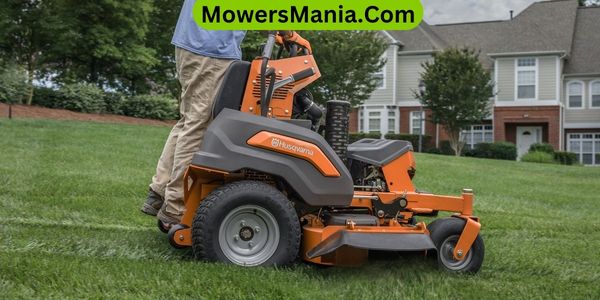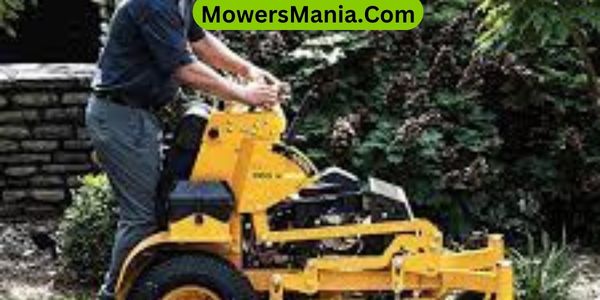Hey there! Ever seen those landscapers zipping around on stand-on mowers? Wondering how they work?
A stand-on mower is a compact, agile machine designed for efficient lawn care. It’s perfect for navigating tight spots and handling large areas with ease.
Let’s dive in and explore how these mowers operate, from the cutting mechanism to maneuverability and control features.

You’ll also discover some maintenance tips and safety considerations for using a stand-on mower. By the end, you’ll have a solid grasp of how these impressive machines get the job done.
Let’s get mowing!
Stand-On Mower: A Brief Overview
If you’re considering a stand-on mower, you’ll appreciate its maneuverability and efficiency for tackling larger lawns and commercial properties.
These mowers are designed for ease of use, allowing you to cover more ground in less time. With their compact size and ability to turn on a dime, stand-on mowers excel in navigating around obstacles like trees, flower beds, and other landscaping features.
The ergonomic design provides comfort during extended use, reducing fatigue and increasing productivity.
One of the key advantages of a stand-on mower is its ability to provide a clear line of sight, allowing for better precision when cutting grass.
This is particularly beneficial when working in tight or intricate spaces. Furthermore, the stand-on design offers improved weight distribution, reducing the risk of turf damage, especially on wet or sensitive surfaces. The efficient use of space also allows for easy transportation and storage when not in use.
Advantages of Stand-On Mowers
When using a stand-on mower, you’ll appreciate the maneuverability it offers in tight spaces, making it easier to navigate around obstacles.
The improved visibility and control that come with standing on a mower allow you to make precise cuts and efficiently cover the entire lawn.
Additionally, standing while operating the mower helps reduce operator fatigue, allowing you to work for longer periods without feeling as tired.
Maneuverability in Tight Spaces
Achieve exceptional maneuverability in tight spaces with stand-on mowers, allowing you to navigate around obstacles with ease and precision.
The stand-on design provides a compact footprint, enabling you to maneuver through narrow gates, around trees, and along flower beds effortlessly.
With the operator standing on the mower, you have a clear, unobstructed view of the mowing path, which enhances your ability to make precise turns and navigate tight corners.
The ability to shift your weight and pivot quickly on a stand-on mower further enhances its maneuverability in confined spaces, making it ideal for intricate landscaping or areas with multiple obstacles.
This agility ultimately translates to increased productivity as you can efficiently cover intricate landscapes with minimal effort and time.
Improved Visibility and Control
The stand-on mower’s elevated platform provides you with improved visibility and control over the mowing path, enhancing your efficiency and precision.
By standing on the mower, you have a better vantage point to see obstacles, terrain changes, and potential hazards in the mowing area.
This heightened visibility allows you to adjust your mowing pattern and navigate around obstacles more effectively, reducing the risk of accidents and damage to the mower.
Moreover, the standing position gives you greater control over the machine, enabling quick and precise turns, especially in tight spaces.
You can easily shift your weight to maneuver around trees, flower beds, and other obstacles with enhanced agility. This improved control ultimately leads to a more uniform and professional-looking lawn.
Reduced Operator Fatigue
Standing on a mower not only improves visibility and control but also reduces operator fatigue, making it a practical choice for long hours of mowing.
By standing, you can easily shift your weight and change positions, reducing the strain on your body.
This constant movement helps prevent the stiffness and discomfort that can come from sitting for extended periods.
Additionally, the upright stance promotes better posture, decreasing the likelihood of back and neck pain.
The ability to step on and off the mower quickly during brief stops also provides relief and helps maintain energy levels.
With reduced fatigue, you can stay focused and efficient throughout the mowing process, ultimately increasing productivity and minimizing the physical toll of the job.
Understanding the Cutting Mechanism

When you operate a stand-on mower, the blade rotation is crucial for efficient cutting. Adjusting the cutting height allows you to achieve precision and control over the grass length.
Plus, the maneuverability of stand-on mowers makes it easier to navigate through tight spaces, ensuring a thorough and even cut.
Blade Rotation for Cutting
How exactly do the blades on a stand-on mower rotate to effectively cut the grass? The blade rotation for cutting is a crucial aspect of a stand-on mower’s functionality.
Here’s how it works:
- Counter-Rotating Blades: Stand-on mowers often use counter-rotating blades, which rotate in opposite directions to each other.
- Overlap: The blades are strategically positioned to ensure that they overlap, ensuring a thorough and clean cut.
- High-Speed Rotation: The blades rotate at high speeds, swiftly slicing through the grass with precision.
- Mulching Capability: Some stand-on mowers have blades designed for mulching, finely chopping grass clippings and dispersing them back onto the lawn.
Understanding the blade rotation mechanism provides insight into the efficiency and effectiveness of stand-on mowers in maintaining well-groomed lawns.
Height Adjustment for Precision
To achieve precision in cutting, you adjust the height of the mower deck using the lever located on the side of the machine.
This allows you to customize the cutting height according to the specific needs of your lawn. By raising or lowering the deck, you can ensure an even and consistent cut across the entire area.
Understanding the cutting mechanism and how the height adjustment works is crucial for maintaining a healthy lawn.
Below is a table summarizing the key points of the height adjustment for precision:
| Height Adjustment | Result |
|---|---|
| Higher setting | Ideal for tall grass or uneven terrain |
| Lower setting | Suitable for shorter grass or a well-maintained lawn |
| Level adjustments | Ensures an even cut across the entire lawn |
| Regular checks | Important for maintaining the health of the grass |
Understanding and utilizing the height adjustment feature will help you achieve a perfectly manicured lawn.
Maneuverability in Tight Spaces
When mowing in tight spaces, maneuverability is essential for navigating around obstacles and ensuring a precise cut.
- Zero-turn radius: Stand-on mowers feature a zero-turn radius, allowing you to pivot on the spot and easily navigate tight corners.
- Articulating deck: The mower’s deck can move independently from the main body, enabling it to hug the contours of the ground and maneuver around obstacles smoothly.
- Quick steering response: With responsive steering controls, you can make quick and precise adjustments to avoid obstacles and maintain a consistent cutting pattern.
- Compact design: The stand-on mower’s compact and agile design makes it ideal for maneuvering through narrow passages and intricate landscapes, ensuring no area is left uncut.
Maneuverability and Control Features
You can easily maneuver a stand-on mower using its intuitive control features, allowing you to efficiently navigate around obstacles and tight spaces in your lawn.
Stand-on mowers are designed with precise steering controls that enable you to make quick and sharp turns, enhancing your ability to maneuver through complex lawn layouts.
The controls are often ergonomically positioned, placing everything within easy reach, ensuring that you can operate the mower with minimal effort and maximum comfort.
One key control feature is the responsive steering system, which allows you to effortlessly change direction as you mow.
This feature is particularly useful when maneuvering around trees, flower beds, or other obstacles, as it provides the agility needed to weave through tight spaces.
Additionally, stand-on mowers are equipped with intuitive speed controls, enabling you to adjust your mowing pace according to the specific requirements of different areas in your lawn.
Furthermore, many stand-on mowers come with advanced technology such as zero-turn capability, which allows for precise and efficient navigation.
This feature permits you to pivot the mower 360 degrees in place, offering unparalleled maneuverability and control, especially in confined spaces.
Maintenance and Care Tips
Keep up with regular maintenance to ensure your stand-on mower operates smoothly and efficiently.
Here are some essential maintenance and care tips to keep your stand-on mower in top condition:
- Check and Change the Oil: Regularly check the oil level and quality. Change the oil according to the manufacturer’s recommendations to ensure proper lubrication and engine performance.
- Sharpen Blades: Dull blades can damage the grass and affect the overall cutting quality. Keep your blades sharp to achieve a clean and precise cut.
- Inspect Belts and Cables: Routinely inspect the belts and cables for any signs of wear and tear. Replace them as needed to maintain proper functionality.
- Clean the Deck and Undercarriage: Remove grass clippings, dirt, and debris from the deck and undercarriage after each use. This helps prevent corrosion and keeps the mower running efficiently.
Safety Considerations for Operation

Regularly maintaining your stand-on mower is crucial to ensure safe and efficient operation. In addition to maintenance, there are several safety considerations to keep in mind when operating a stand-on mower.
Always wear appropriate personal protective equipment, including eye protection, hearing protection, and sturdy footwear.
Before starting the mower, ensure that the area is clear of obstacles, bystanders, and pets. It’s important to familiarize yourself with the mower’s controls and operation manual to understand how to safely operate the equipment.
When mowing on slopes, use caution and avoid making sudden turns or maneuvers that could lead to loss of control.
Lastly, always turn off the mower and wait for the blades to completely stop before performing any maintenance or clearing blockages.
| Safety Considerations | Emotional Response |
|---|---|
| Wearing protective gear | Safety and reassurance |
| Clearing the mowing area | Responsibility and care |
| Understanding the manual | Knowledge and empowerment |
| Exercising caution on slopes | Alertness and caution |
Frequently Asked Questions [FAQs]
Can a Stand-On Mower Be Used on Hilly Terrain or Slopes?
Yes, a stand-on mower can be used on hilly terrain or slopes. It provides better visibility and control compared to a traditional sit-down mower, making it easier to navigate uneven terrain without compromising on mowing quality.
What Are the Recommended Safety Gear and Clothing to Wear When Using a Stand-On Mower?
When using a stand-on mower, wear protective gear such as safety glasses, ear protection, sturdy shoes, and close-fitting clothing. It’s crucial for your safety to follow these recommendations and ensure a safe mowing experience.
Are Stand-On Mowers Suitable for Use on Wet or Damp Grass?
Yes, stand-on mowers are suitable for use on wet or damp grass. However, it’s important to be cautious as wet surfaces can impact traction and maneuverability. Be sure to adjust your mowing speed accordingly for safety.
How Often Should the Blades of a Stand-On Mower Be Sharpened or Replaced?
You should sharpen or replace the blades of a stand-on mower at least once a year, or more often if you mow frequently or encounter tough conditions. Sharp blades ensure a clean cut and promote a healthy lawn.
What Is the Average Lifespan of a Stand-On Mower and How Can It Be Extended Through Proper Maintenance?
To extend the average lifespan of a stand-on mower through proper maintenance, regularly clean the deck and engine, check and change the oil, and replace the air filter. Keep the blades sharp and balanced, and store it in a dry, covered area.
Conclusion
So, now you know what a stand-on mower is and how it works.
With its maneuverability, control features, and cutting mechanism, it offers many advantages for maintaining your lawn.
Just remember to prioritize safety and regular maintenance to keep your stand-on mower in top working condition.
Happy mowing!



